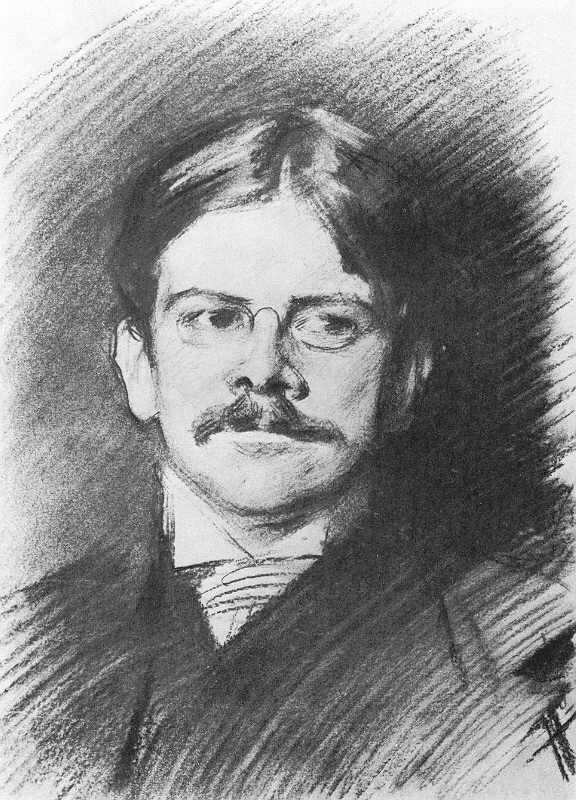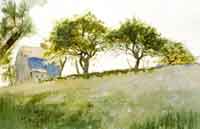Edwin
Austin Abbey
John Singer
Sargent -- American
painter
1888-1889 ?
Yale
University Art
Gallery, New Haven, CT
Pencil
14 x 10 1/8
in.
Jpg:
local
Edwin Austin Abbey,
(American artist,
1852-1911) best known for his illustrations for Harpers magazine, his
mural
work for the Boston Public Library; murals at his native state capitol
in Harrisburg, Pennsylvania; his many theatrical / literary paintings;
and The Coronation of Edward VII (1902-1904, Buckingham Palace)
Edwin was born in
Philadelphia, began
his training as an artist under Isaac Williams, a portrait and
landscape
painter who had studied with John Neagle and Christian Schussele, a
German-born
history painter.
He moved to New
York when he was
14, taking a full-time position drawing for Harper and Brothers, the
publisher
of a news weekly, a literary monthly, and books. Through Harper's he
became
friends with Francis
Davis Millet and other prominent Harper illustrators such as Edwin
Blashfield, Alfred Parsons.
In 1878, Harper's
sent him to England
to do background research for an edition of Robert Herrick's poetry.
From
that moment on, the pull to Great Britain and Europe would never abate
and he finally settled in London in 1882 at the age of 30. When his
friend
Frank Millet moved to Broadway,
Abbey went with him forming the nucleus of an artist colony that would
included John Singer Sargent among others.
Most of
his early work was in pen and ink, which he showed a strong
ability for; but once he turned to oils and color, he did so in a big
way
.
After
Edwin married, he settled in
Morgan Hall

Morgan
Hall
where he and
Sargent set up a studio
to begin the Boston Public Library murals.
Abbey along with
his other friends
from Harpers tended to lean more towards the English Pre-Raphael
Brotherhood
style in their artwork of genera scenes which was popular in the
public.
In his mural work for the Boston Public Library, a commission he
received
in 1890 along with John Singer Sargent and Augustus
Saint-Gaudens, the
paintings followed more of a theatrical arrangement of characters
on stage than a "recreation" of a supposed historical scene. This trend
carried forward in his series on Shakespearian plays in the mid
to
late '90's.
From: The Butler
Institute of
American Art
Edwin Abbey was a
man whose facility
for illustration subverted his potential and reputation as a fine
artist.
A major portion of his career was spent in the fulfillment of
illustration
and mural commissions. He was fascinated by medieval England and
English
literature, and was lucky to have an equally interested public. Because
of his affiliation with Harper's, Abbey's audience was large.
Abbey's career was
driven more by
his imagination of historic events than by his direct observation of
the
light and life around him, for he surely had sufficient ability to
place
him among the best of his contemporaries. In choosing to be an
illustrator
of medieval life he satisfied a personal and public interest, rather
than
breaking new ground as an observer or technician.
The principle
monuments of his career
are his murals, Quest for the Holy Grail (1890-1902, Boston Public
Library),
The Coronation of Edward VII (1902-1904, Buckingham Palace), and the
decorations
of the Pennsylvania State Capitol in Harrisburg which, unfinished at
his
death in 1911, were completed by Sargent. Two of his principal oil
paintings
were May Day Morning (1890, Yale University Art Gallery), his
well-received
first Royal Academy entry, and Richard, Duke of Gloucester, and the
Lady
Anne (1896, Yale University Art Gallery), which was based on a scene in
Shakespeare's Richard III.
(JOSEPH
KEIFFER)
Notes:
I have seen Sargent's
drawing dated
1888 and 1889. I don't know which is correct. I know for a fact it was
featured in Henry James' article: "Our Artist in Europe"; for
Harper's
New Monthly Magazine, Volume LXXIX, Page 50-66; June to November 1889
--
the magazine is reproduced at Cornell
Making of America
American
painter
and illustrator, active in England. He began his artistic training in
1866,
studying drawing with the Philadelphia portrait and landscape painter
Isaac
L. Williams (1817--95). In 1868 he attended evening classes in drawing
at the Pennsylvania Academy of the Fine Arts under Christian Schussele
(?1824--79). In the same year Abbey began to work as an illustrator for
the Philadelphia publishers Van Ingen & Snyder. In 1870 Harper's
Weekly
published the Puritans' First Thanksgiving, and in 1871 Abbey moved to
New York to join the staff of Harper & Brothers, thus inaugurating
his most important professional relationship. Throughout the 1870s
Abbey's
reputation grew, both for his detailed exhibition watercolours and for
his elegant line drawings, which, translated to wood-engravings in
numerous
periodicals, illustrated both factual and fictional events of the past
and present. The influences on him were mainly English, in particular
the
works of the Pre-Raphaelite Brotherhood and illustrations in the
English
press, which he studied avidly. The success of his illustrations to
some
of Robert Herrick's poems, such as Corinna's Going A-Maying in Harper's
New Monthly Magazine (May 1874), prompted Harper & Brothers in 1878
to send Abbey to England to do a complete series of drawings for an
illustrated
gift-book, Selections from the Poetry of Robert Herrick (New York,
1882).
On his arrival in England, Abbey found his spiritual home, and except
for
a few trips, he never left.
Abbey, a small,
handsome, athletic man, had a genius for forging long-lasting and often
profitable friendships. In 1877 he helped to found the Tile Club, which
included among its members the architect Stanford White, Augustus
Saint-Gaudens
and Winslow Homer, whose activities resulted in gift-books and lengthy
magazine articles. Abbey's most intense friendship was with the English
landscape painter and illustrator Alfred Parsons (1847--1920). The two
artists shared studios and gallery exhibitions, travelled together
widely
and collaborated on several projects, most notably the gift-books Old
Songs
(New York, 1889) and The Quiet Life (New York, 1890). Abbey derived
much
of the inspiration for these from his long sojourns in the English
countryside,
especially, from 1885 to 1889, as one of the central figures in the
artists'
colony at Broadway (Hereford & Worcs), along with Parsons, Frank
Millet
(1846--1912) and John Singer Sargent.
Abbey undertook
illustrative commissions throughout his life (his illustrations to
Shakespeare's
plays being especially noteworthy), but from 1889 on he devoted more
time
to mural projects and oil paintings. In 1890 he sent his first major
oil,
May Day Morning (New Haven, CT, Yale U. A.G.), based on one of the
Herrick
illustrations, to the Royal Academy Summer Exhibition, where it was
favourably
received. Until 1910 Abbey exhibited there frequently, and he was
elected
ARA in 1896 and RA in 1898. His exhibited works were usually based on
Shakespearean,
troubadour or Renaissance themes. Large and richly coloured, the
paintings
reflect Abbey's fascination with the stage, particularly in the
arrangement
of the figures, their poses and sumptuously coloured costumes (Abbey
designed
the costumes for John Hare's Tosca (1889) and Sir Henry Irving's
Richard
II (1898), among other productions). Although he received many honours
and awards, the signal event of Abbey's career was the commission in
1902
to paint Edward VII's coronation (London, Buckingham Pal., Royal Col.).
The major projects
of Abbey's later life were commissions for murals. He decorated the
delivery
room of McKim, Mead & White's Boston Public Library with a 15-panel
series (1890--1901) based on the Quest for the Holy Grail (see fig.).
Works
for the Royal Exchange, London, and other commissions followed. In 1902
Abbey began the decorations for the Pennsylvania State Capitol at
Harrisburg.
An allegory of the state's history and its resources, Abbey's work here
departed from the schematic narrative of his other murals and adopted a
full-blown rhetorical style related to the work of Kenyon Cox and Edwin
Howland Blashfield.
BIBLIOGRAPHY
E.
V. Lucas:
Edwin Austin Abbey, Royal Academician: The Record of his Life and Work,
2 vols (London, 1921)
Edwin
Austin
Abbey (1852--1911) (exh. cat., ed. K. A. Foster and M. Quick; New
Haven,
CT, Yale U. A.G., 1973)
M.
Simpson:
'Windows on the Past: Edward Austin Abbey and Francis Davis Millet in
England',
Amer. A. J., xxii/3 (1990), pp. 64--89
------:
Reconstructing
the Golden Age: American Artists in Broadway, Worcestershire, 1885 to
1889
(diss., New Haven, CT, Yale U., 1993)
Unfaded
Pageant:
Edwin Austin Abbey's Shakespearean Subjects (exh. cat. by L. Oakley,
New
York, Columbia U., Miriam & Ira D. Wallach Gal., 1994)
SOURCE: www.groveart.com
|



